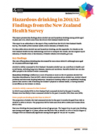This report presents key findings about alcohol use and hazardous drinking among adults aged 15 years and over. These results come from the 2011/12 New Zealand Health Survey.
Hazardous drinking refers to an established drinking pattern that carries a risk of harming physical or mental health, or having harmful social effects to the drinker or others. It is defined as a score of 8 or more on the 10-question Alcohol Use Disorders Identification Test (AUDIT).
Results are available by sex, age group, ethnic group and socioeconomic deprivation (NZDep). This report is an addendum to the report of key results from the 2011/12 New Zealand Health Survey, The Health of New Zealand Adults 2011/12.
Key Results
- In 2011/12, most adults had consumed alcohol in the past 12 months (80%). This is fewer than in 2006/07 (84%). Decreases in past-year drinking were generally seen across all age groups, but particularly among 15–17 year olds.
- Among people who had consumed alcohol in the past 12 months (‘past-year drinkers’), one in five (19%) had hazardous drinking patterns. This is about 532,000 people.
- Since 2006/07, the level of hazardous drinking among past-year drinkers has significantly decreased for men (from 30% to 26%), but not among women (13% to 12%).
- People aged 18–24 years (particularly men) are at higher risk of hazardous drinking. Among past-year drinkers, about 44% of men and 26% of women aged 18–24 years have hazardous drinking patterns. However, the rate of hazardous drinking has decreased significantly in past-year drinkers aged 18–24 years from 2006/07 (49%) to 2011/12 (36%).Māori have similar rates of past-year drinking as the total population, but have higher rates of hazardous drinking. Rates of hazardous drinking among Māori adults have decreased since 2006/07, (from 33% in 2006/07 to 29% in 2011/12).
- While Pacific adults are less likely to drink alcohol, those who do are more likely to have hazardous drinking patterns (35%) than adults overall (19%).
- People living in more deprived areas are less likely to have consumed alcohol in the past 12 months, but are more likely to have hazardous drinking patterns (18%), than people living in less deprived areas (11%).

